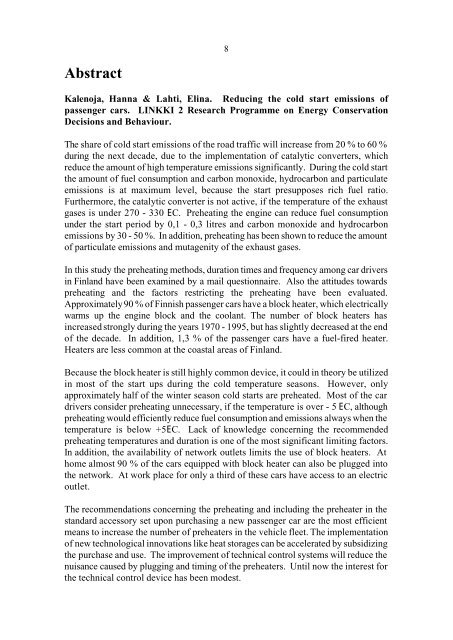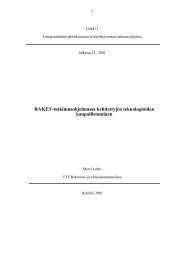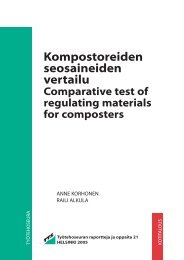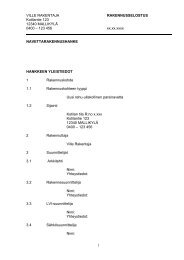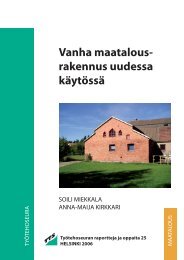Create successful ePaper yourself
Turn your PDF publications into a flip-book with our unique Google optimized e-Paper software.
8<br />
Abstract<br />
Kalenoja, Hanna & Lahti, Elina. Reducing the cold start emissions of<br />
passenger cars. LINKKI 2 Research Programme on Energy Conservation<br />
Decisions and Behaviour.<br />
The share of cold start emissions of the road traffic will increase from 20 % to 60 %<br />
during the next decade, due to the implementation of catalytic converters, which<br />
reduce the amount of high temperature emissions significantly. During the cold start<br />
the amount of fuel consumption and carbon monoxide, hydrocarbon and particulate<br />
emissions is at maximum level, because the start presupposes rich fuel ratio.<br />
Furthermore, the catalytic converter is not active, if the temperature of the exhaust<br />
gases is under 270 - 330 EC. Preheating the engine can reduce fuel consumption<br />
under the start period by 0,1 - 0,3 litres and carbon monoxide and hydrocarbon<br />
emissions by 30 - 50 %. In addition, preheating has been shown to reduce the amount<br />
of particulate emissions and mutagenity of the exhaust gases.<br />
In this study the preheating methods, duration times and frequency among car drivers<br />
in Finland have been examined by a mail questionnaire. Also the attitudes towards<br />
preheating and the factors restricting the preheating have been evaluated.<br />
Approximately 90 % of Finnish passenger cars have a block heater, which electrically<br />
warms up the engine block and the coolant. The number of block heaters has<br />
increased strongly during the years 1970 - 1995, but has slightly decreased at the end<br />
of the decade. In addition, 1,3 % of the passenger cars have a fuel-fired heater.<br />
Heaters are less common at the coastal areas of Finland.<br />
Because the block heater is still highly common device, it could in theory be utilized<br />
in most of the start ups during the cold temperature seasons. However, only<br />
approximately half of the winter season cold starts are preheated. Most of the car<br />
drivers consider preheating unnecessary, if the temperature is over - 5 EC, although<br />
preheating would efficiently reduce fuel consumption and emissions always when the<br />
temperature is below +5EC. Lack of knowledge concerning the recommended<br />
preheating temperatures and duration is one of the most significant limiting factors.<br />
In addition, the availability of network outlets limits the use of block heaters. At<br />
home almost 90 % of the cars equipped with block heater can also be plugged into<br />
the network. At work place for only a third of these cars have access to an electric<br />
outlet.<br />
The recommendations concerning the preheating and including the preheater in the<br />
standard accessory set upon purchasing a new passenger car are the most efficient<br />
means to increase the number of preheaters in the vehicle fleet. The implementation<br />
of new technological innovations like heat storages can be accelerated by subsidizing<br />
the purchase and use. The improvement of technical control systems will reduce the<br />
nuisance caused by plugging and timing of the preheaters. Until now the interest for<br />
the technical control device has been modest.


